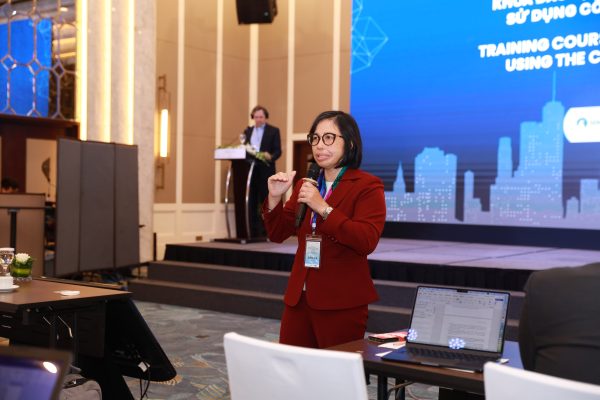ETS and carbon markets receive great attention from both policymakers and businesses
04/03/2024
At the training course on ETS and carbon markets held in Hanoi at the end of February 2024, Ms. Dang Hong Hanh, Team Leader, Climate Change Policy Expert, Co-Founder, and Executive Director of the Energy and Environment Consultancy Joint Stock Company (VNEEC) emphasized that with the goal of voluntarily reducing 15.8% and reducing 43.5% of GHG emissions by 2030, with international support compared to the emissions in the Business-As-Usual (BAU) Scenario, building an effective ETS plays a key role in achieving the Nationally Determined Contributions (NDC) target.
(Photo: Ms. Dang Hong Hanh, Team Leader, Climate Change Policy Expert, Co-Founder, Executive Director of Energy and Environment Consulting Joint Stock Company (VNEEC))
By placing a cap on total emissions and allowing businesses to trade emissions allowances, ETS creates economic incentives to help businesses find solutions to effectively reduce their GHG emissions. Additionally, revenue from allowance auctions can be reinvested in climate-related projects, further supporting the country’s efforts in the fight against climate change. According to the roadmap, the ETS and credit mechanism will be piloted from 2025 – 2027, with businesses in the GHG inventory reporting list in March 2025 required to submit reports.
(Photo: Ms. Roxanne Tan, Senior Manager of Climate Policy, Finance and Carbon Markets at South Pole)
Ms. Roxanne Tan, Senior Manager of Climate Policy, Finance and Carbon Markets at South Pole, highlighted that carbon pricing is at the core of many countries’ strategies to mitigate GHG emissions. Carbon pricing acts as an economic tool. By putting a price on carbon, the economic burden related to damages caused by GHG emissions is shifted to the responsible emitting entities. This approach provides flexibility for these entities to decide how, where, and when to reduce emissions at the lowest overall cost.
Carbon pricing is a powerful tool to stimulate various behavioral responses to reduce energy consumption and transition to low-carbon fuels or processes. Simultaneously, it generates income for budgets that can be used for various socio-economic goals.
(Photo: Mr. Michael Mehling, Capacity Training Expert, Deputy Director of the Center for Energy and Environmental Policy Research (CEEPR) at Massachusetts Institute of Technology (MIT))
(Photo: Mr. Josh Margolis, Carbon Simulation Expert, manager and administrator of CarbonSim)
The practical session using the CarbonSim simulation tool is coordinated and guided by Mr. Josh Margolis, the manager and administrator of CarbonSim. During the simulation, participants take on the roles of businesses in the market with specific emission reduction targets. Players are required to make strategic decisions regarding the choice of abatements, as well as participate in auctions and trading of emission allowances through auctions and exchanges. The ultimate goal is to achieve the facility’s emission reduction target with minimal cost, which is also the goal that businesses need to accomplish when participating in real-world ETS.
(Photo: Market simulation class)
(Photo: Market simulation class)
The training course on ETS and carbon markets as well as practical exercises using simulation tools were very exciting, receiving a lot of positive feedback from participants about interactivity and real-world applicability of the sessions. Ms. Nguyệt Anh from IFC expressed her appreciation, stating, “This is the most beneficial and interesting training course I have ever attended.” Many participants agreed: “The course is truly excellent, providing me with a lot of new insights”,…
(Photo: Participants expressing their feelings)
(Photo: Participants expressing their feelings)
Following the success of two training courses on ETS and carbon markets in Hanoi, the next two training courses are expected to be held in May in Ho Chi Minh City. This is an unmissable opportunity for policymakers and large-emitting businesses in the Southern provinces and surrounding regions. Participants in the course will gain knowledge about ETS and the carbon market and have the opportunity to practice using the CarbonSim market simulation tool, equipping themselves and their organizations with the necessary knowledge to be at the forefront in addressing the challenges of climate change and promoting sustainable development.










